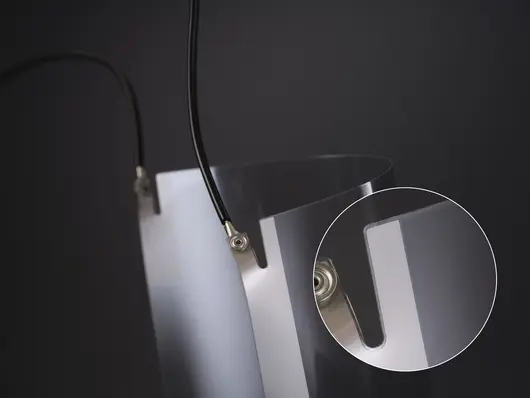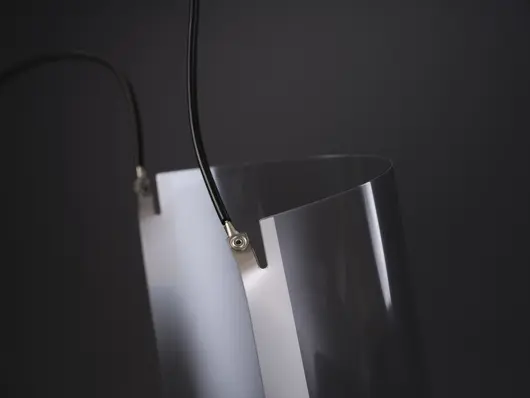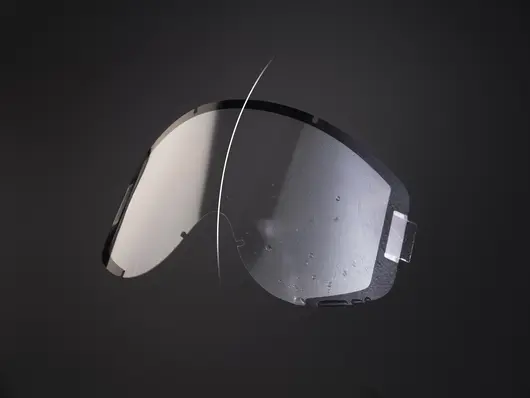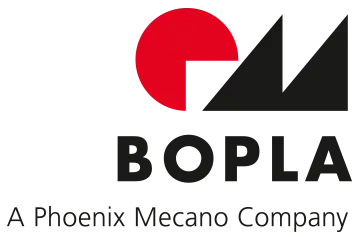More than state of the art: transparent film heaters from KUNDISCH, your technology partner
Bünde/Villingen-Schwenningen, October 4, 2023. Almost invisible, but so effective. Transparent heating systems are real problem solvers in a very wide range of sectors. The automotive industry is a pioneer in this, including with heated headlamps and mirrors. When fitted in automobiles, transparent heating systems make it possible for vehicle automation sensors to generate precise 3D mapping in all weather situations. In the meantime, the field of use for transparent heating systems has expanded many times. KUNDISCH GmbH & Co. KG, the Villingen-Schwenningen manufacturer of membrane keypads and touch systems, uses special technology for its heating films.
Harsh weather outdoors, temperature variations in a terrarium – together with other sensors, optical cameras must withstand the conditions existing in their field of application. In order to ensure that these cameras remain active, the field of view must always be free of condensation and ice. Harsh weather or temperature variations can become a genuine problem and put correct functioning at risk. The solution?Transparent heating systems which protect both the field of view and the sensors against external influences – always with maximum transparency.

Smart heating: An important future-oriented field for KUNDISCH
For many years, KUNDISCH, the manufacturers of membrane keypads and touch systems, have been developing solutions in the field of transparent electronics. One transparent electronics sector in which the KUNDISCH company is experiencing increasing demand is smart heating by means of transparent film heaters. For Sebastian Gepp, development manager for printed electronics at KUNDISCH, this is not surprising. He explains that film heaters which make use of transparent electronics offer numerous advantages. He points out that the main advantage of a transparent film heater in comparison with traditional heating systems is that it heats up rapidly. “For example, by using a film heater, a pane of glass can be heated to 60 degrees within a few seconds. Traditional heating systems work by means of fans and a heating wire, and primarily they heat the ambient air. This takes much longer, and in addition it requires a lot of energy.”

Metal mesh technology
The challenge regarding the manufacture of transparent film heaters is to use a material which provides both sufficient conductivity and transparency. At KUNDISCH, this is where metal mesh technology comes into play, because these are the exact conditions which it fulfills. By means of this technology, homogenous transparent conductive films are manufactured at printed layers which can be used as heating elements for transparent layers. To do this, KUNDISCH normally prints two silver wires into the film and they conduct the electricity into the film. A transparent coating is located between the two silver-printed wires. The coating consists of a mixture of copper and carbon, is highly conductive and very transparent.Sebastian Depp explains,
»You can visualise it as wafer-thin copper wires on the film. You can only see them with the naked eye if you have had practice. That’s what is special about this technology. In contrast to other systems, the wafer-thin, hardly visible material makes much lower resistances possible. Because of this, users achieve the same heat output with less electricity.«
-Sebastian Gepp, Development Manager Printed Electronics at KUNDISCH
An additional advantage of this technology is the possibility of structuring the material in accordance with the customer’s requirements by means of printing technology. This is because it is not always possible to use a rectangular coated surface in order to achieve for example a required heat output with specified electrical parameters. In this way, KUNDiSCH’s technology makes it possible to adapt the products exactly to the application.
The transparent electrical heating film is typically incorporated by “sandwiching” a conductive material between layers of glass or clear plastic, traditionally polycarbonate or acrylic.
The advantage of this method becomes especially clear when transparent heating films need to be manufactured for large areas, such as for windscreens. Current technology used to heat windscreens involves using robots to lay the wires. A robot lays a thin wire with clearances of one centimetre and has to cover each position to do this. As Sebastian Gepp explains, “This is a process which, most of all, takes more time than KUNDISCH’s metal mesh technology. In this way, he explains, KUNDISCH can print a square metre very homogeneously in seconds, but a robot needs several minutes to lay the wires. Consequently, the level of productivity we can achieve is many times greater than that which today’s technology can provide.”
Transparent heating systems in different technical variants have been available for a long time. However, the material which KUNDISCH uses and which makes the innovative method possible has only been available on the market for a few years. “For a long time, procurement was the problem. In the past, smart heating systems required alternative technologies such as wires or ITO coatings,” Sebastian Gepp explains.

A problem solver in many sectors
The main driver of this technology is the automotive industry, because the heating films are transparent not only to the eye, but also to laser and radar systems. In this way, the transparent heating films support the functioning of distance measuring devices in vehicles, even when the vehicle is iced up. Whether it is a matter of robots unloading lorries, self-driving forklift trucks or agricultural vehicles, it is primarily those sectors which are characterised by a high degree of automation that benefit from the transparent heating systems.
They are also found in the field of medicine, for example in incubators for newborn children. In addition they can be integrated in a range of displays, for example in e-paper readers. Sebastian Gepp points out that transparent heating films are a real problem solver in other sectors, and he mentions one specific, if extreme, example. “Our customers include lamp manufacturers whose products are used in the Antarctic and other places. Nowadays, the use of light bulbs whose heat counteracts ice is not longer permitted, and such a lamp ices up under these conditions. The result is that the bulb isn’t bright enough.” Transparent heating films prevent this.


